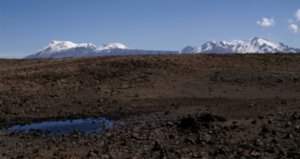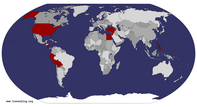Advertisement
Published: June 14th 2009

 View from
View from
The highest point of the Colca Canyon at 4800mA miners strike at 3am in the morning! Could this day possibly get any worse? After being on the bus for 5 hours, we were woken up at 3am to be told that we would be forced to sit on the side of a road, along with dozens of other trucks, buses, & cars waiting for the local miners to remove the boulders & loose stones they had put on the road to block the way.
By 9am - there was still no resolution with the miners, who, by this stage were blind drunk and threatening to blow up the buses if their demands were not met by the local government. We only had two alternatives; we could either wait on the bus until the road cleared; or alternatively walk the distance across the bridge, through the miners, and get another local bus to Arequipa. We chose the second option, and so, amidst the laughing catcalls and snarls of the miners telling us to go back home to our own country, we made our way across the bridge to our waiting bus to take us the remaining distance. Not the best wake up call after

 Vicuñyas run wild
Vicuñyas run wild
The road on the way to the Colca Canyon is set within a nature reserve for Vicuñyas and other native animalstravelling for 12 hours straight, loaded down with backpacks and vulnerable to the volatility of the miners watching us.
We were supposed to arrive in Arequipa at 9am that morning, but at this stage of our journey we were not expected to be there until nearer on 6-7pm that evening, not leaving us with very much time to explore the city for the time we had. Later that evening, tired, exhausted, and barely able to string two sentences together we eventually got to our hostel, dumped our bags and went out for our first walk & our first proper meal after almost 19 hours on the move.
Rather disappointed but not unsurprisingly, we didn’t see anything in Arequipa that night other than the insides of our eyelids!
Cañón del Colca As a means of preparation for the Inca trail, we were spending a few days prior to the start of the trail at locations of high altitude - The Cañón del Colca being one of them.
Considered to be the World’s Deepest Canyon (last survey being over 4200m) it is apparently over twice the size of the Grand Canyon, in the USA. To get

 Cookies anyone?
Cookies anyone?
At the coffee shop along the way to the Colca Canyon. Sexual Invigoration Cookies? FYI - They dont work! to the canyon itself we hired a minivan to drive us the distance along the Reserva Nacional Salinas y Aguada Blanca, a national park where native vicuñas (a member of the alpaca & llama family, whose wool is the most expensive in the world) roam free.
This was high Andean ‘Altiplano’ country and was my first chance to get a glimpse of the Andes mountain range. As we drove along the way to our base of Chivay (a town in the Cañón del Colca) we had to stop off at a coca leaf shop to buy some coca leaves to help with the altitude sickness & drink some coca leaf tea. Then it was off along the highway, through some spectacular scenery till we got to our highest point of the day at 4800m. It was here that I got my best view of the Andes; made a blessing to Patchamama by stacking up rocks one-on-top of each other over my chewed up coca leaves and using the toilet in the worlds highest outside squat toilet in the world (In my opinion anyway). It was cold! I could hardly breathe (but that may have been something to do with
the fact that I was staring at the Andes!!) but it was scenery that I had never seen before.
Its hard to use the same old words of spectacular or amazing because sometimes they just don’t make the grade - You almost have to witness it yourself to truly appreciate it - but it was spectacular! It was amazing and I was dumbstruck at being the one standing there looking out into the distance to see it for myself.
It’s time for dinner!! After arriving in Chivay we went for a short walk around the hills of the valley, to see some of the pre-inca sites before spending the later afternoon in the local public hot springs to ease my calf muscles and enjoy the cold weather in a very nice hot spring bath.
Clean & relaxed from the springs, we were all then due to spend the evening with a local family in the area to have a meal with them. We were given a previous warning from our guide, that this could possibly involve a feast of ‘cuy’ or guinea pig, which is usually reserved for special occasions - so we were all keen to
see what would be dished up later that night.
We arrived at the home of our local family and were given the best room in the house for our feast of …..yep! ‘Cuy’. The mother of the house even offered us the chance to participate in the preparation of the meal - from start to finish. I couldn’t pass up this opportunity, so I was in there in a flash, going as far as plucking the hair from the meat in preparation for the next step. I’d never before witnessed my food being prepared at this level (excluding fishing of-course). There is something very clinical in being able to get your food from a refrigerated cool room, selecting your cut of meat from rows of styrofoam trays before going home and cooking it that is so far afield from what I was witnessing.
Dinner that night consisted of vegetable soup, cuy & bbq alpaca with some quinona. Could I eat the cuy? Unfortunately - I tried, but found that I enjoyed the alpaca more than the cuy, which was too gamey for me and tasted a bit stronger than rabbit.
Cruz del Condor The next
morning we had an early start to get to the Cruz del Condor to watch the condors flying around in search of their morning meal. Magnificent birds, they can reach over 3 mtrs in diameter when adult and live to over 80yrs old before committing suicide by crashing into the side of a mountain when they know it is their time (or so my guide told me).
We sat close to the edge of the Canyon, where we were lucky enough to get quite up close to see them as they swooped passed in search of carrion. Then it was time for another walk through the valley to get a better glimpse at large sections of the canyon and the surrounding scenery before making our way back to Arequipa.
Arequipa - The White City of Peru We got back earlier than expected into Arequipa to give us some time to explore the city. It is known as the ‘White city’of Peru because of the volcanic stone used to build most of the buildings within the town. Historically a city that has suffered volcanic eruptions and earthquakes every century since the 1500’s, the stones were mined from
the surrounding hills once it was discovered that the volcanic stone helped stabilise the buildings during an earthquake.
Cobblestoned streets, ornate buildings, gas lamps (or at least they looked like it) and wide central squares is what for me, defines Arequipa. My first big city since Lima, it has an elegance that made it a wonderful place to walk around both during the day and especially at night. During our afternoon in the town, I made a beeline for the Museo Santury to get a glimpse of the ‘Juanita - Ice Princess’, the frozen Inca maiden sacrificed atop the summit of Volcano Ampato & discovered in 1995 by an anthropologist named John Reinhard, who was climbing the volcano in search of Inca artefacts. Wonderfully preserved and kept hermetically sealed within a glass block of ice, she was the main asset of the museum. Dressed in the clothes she was sacrificed in, she was a small, fragile, had long black hair and leathery brown skin, quite unlike any of the other mummies I had seen in the past. The museum contained other artefacts, things that were found with her body, along with artefacts found with other children also sacrificed for
other Inca rituals - all rather interesting in their own right, with the only one exception of our monotone guide, who I did not think paused for breath once throughout the 1½ hour tour of the Museum.
With only one free afternoon to visit as much of the city as possible, our next stop after the museum was the ‘Monestario Santa Catalina’. The Monastery occupies an entire block and is surrounded by high walls and was founded in 1580 by a wealthy widow who chose nuns from the richest Spanish families in Peru. We decided to do a night walk around the Monastery by ourselves, without a guide. In the silence, it was eerie walking around peeking through the rooms, lit by candelight and the glow of the kitchen fires. They lived such stark lives, with nothing but a simple bed, chair and desk & an ornate statue of Jesus in every room. Almost every room, had connecting ante-rooms that either led to nowhere or led to steps leading to nowhere and we spent a considerable amount of time running in and out of these rooms trying to scare each other in the darkness.
Toured out and hungry,

 The worlds highest squat toilet?
The worlds highest squat toilet?
At least it was cold enough to remove the smell!we made our way to a local restaurant to try the local speciality ‘Chupe de Camarones’, a shrimp soup made from local river shrimps around Arequipa and mixed with rice & vegetables. The bowl never seemed to end, mounds of shrimp never decreasing. At first, I thought that I would need to order something more substantial - but by then end of the meal, I couldn’t give it away. A fabulous meal, topped off with a few great bottles of Chilean wine. What more did you want? - other than a good night’s rest. That is exactly what I did next!
Advertisement
Tot: 0.25s; Tpl: 0.015s; cc: 17; qc: 74; dbt: 0.09s; 1; m:domysql w:travelblog (10.17.0.13); sld: 1;
; mem: 1.2mb





















